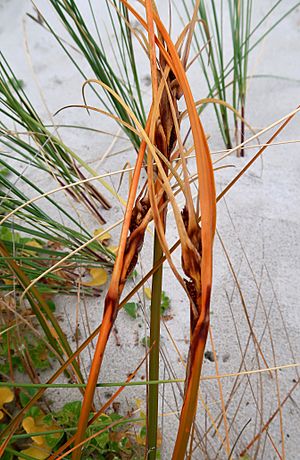Golden sand sedge facts for kids
Quick facts for kids Golden sand sedge |
|
|---|---|
 |
|
| Pīngao, Tauperikaka Point, West Coast, NZ | |
| Scientific classification | |
| Genus: |
Ficinia
|
| Species: |
spiralis
|
| Synonyms | |
|
|
Ficinia spiralis is a special plant known as pīngao, pīkao, or golden sand sedge. It's a type of sedge that grows only in New Zealand, including the Chatham Islands. This plant used to be found everywhere along the coast. However, it has faced tough competition from other plants like marram grass. Animals eating it have also caused problems. Now, pīngao grows only in scattered areas.
Contents
What Pīngao Looks Like
Pīngao is a strong, grass-like plant. It usually grows between 30 and 90 centimeters (about 1 to 3 feet) tall. You can find it on sandy beaches and dunes. This plant is unique to New Zealand. It is easy to tell apart from other dune plants like spinifex or marram grass. When you see a patch of pīngao from far away, it often looks bright orange.
Most pīngao plants have long, tough stems called stolons. These stolons creep along the sand. They get buried by moving sand, leaving only the top parts of the leaves showing. Some pīngao plants in the southern South Island grow in dense clumps. These types do not have many long stolons.
Many strong, rough leaves grow in thick bunches. These bunches are on short, upright stems called tillers. The tillers grow along the stolons. The leaves are narrow, about 2 to 5 millimeters wide. Their color changes as they grow. Young leaves are bright green. Older leaves turn golden yellow, then a deep orange.
Small, dark brown flowers appear in spring. They grow in tight groups around the top part of the upright stem, called a culm. This part is usually 10 to 30 centimeters long. The flowers are mixed with leaf-like parts called bracts. The seeds are shiny, dark brown, and egg-shaped. They are about 3 to 5 millimeters long. Seeds ripen and fall in early summer. Pīngao can also grow new plants from its stolons. This is a type of vegetative reproduction.
How Pīngao Got Its Name
The plant Ficinia spiralis was first described by a scientist named Achille Richard in 1832. He gave it the scientific name Isolepis spiralis. Later, in 1853, Joseph Dalton Hooker moved pīngao to a different group called Desmoschoenus.
In 2010, two scientists, A. M. Muasyaa and P. J. de Lange, did more research. They found that Desmoschoenus and Ficinia were very similar. So, they decided to combine them. This is why pīngao is now known as Ficinia spiralis.
Pīngao in Māori Culture

One Māori name for pīngao is ngā tukemata o Tāne. This means "Tāne's eyebrows." In the Ngai Tahu dialect, it is called pikao. There is a Māori story about how pīngao came to be:
Long ago, there was a big fight between Tāne Mahuta, the God of the Forest, and his brother Takaroa, the God of the Sea. Takaroa was upset because Tāne Mahuta had successfully separated Ranginui, the Sky Father, from Papa-tu-a-nuku, the Earth Mother. Tāne Mahuta wanted to end their fighting. As a sign of peace, he pulled out his eyebrows and gave them to Takaroa. But Takaroa was still too angry to forgive Tāne. He threw the eyebrows back onto the shore. There they grew into Pikao, the Golden Sand Sedge. They now mark the boundary between the forest and the sea. Takaroa is still angry and continues to fight against Tāne Mahuta's forest lands.
Māori use the leaves of pīngao for traditional weaving. The leaves turn a bright yellow when they dry. They are used to make hats (pōtae), bags (kete), and mats (whāriki). Pīngao is also used to create beautiful decorative panels called tukutuku inside a wharenui (Māori meeting house). The leaves from different pīngao plants can vary. Some are longer, wider, or stronger, which affects how they are used for weaving. Māori also used pīngao leaves for roofing.
Protecting Pīngao
Pīngao is very important because it helps hold sand dunes together. However, other plants brought to New Zealand, like marram grass and Pinus radiata trees, compete with it. Weeds like yellow tree lupins also cause problems. Marram grass and pine trees make the dunes more stable. Because of this, large areas of pīngao were burned in the past.
Now, pīngao is only found in scattered areas along the New Zealand coast. Community groups and the Department of Conservation are working to help it. They actively plant pīngao when they are restoring native ecosystems.
See also
 In Spanish: Ficinia spiralis para niños
In Spanish: Ficinia spiralis para niños


